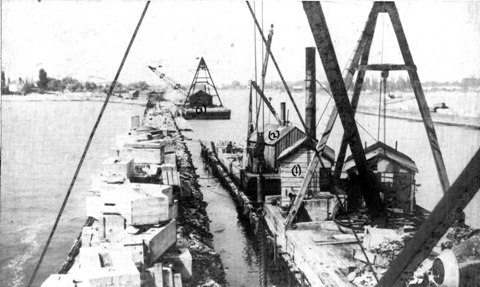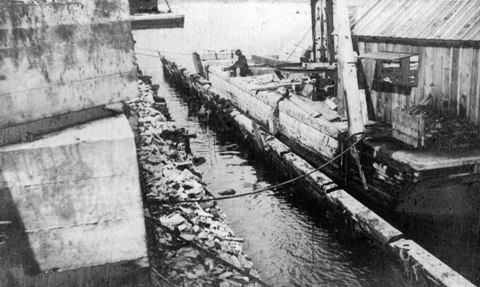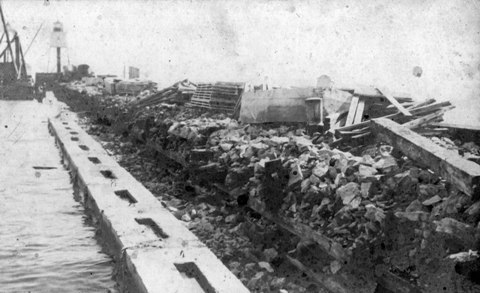From various sources I
learnt that on May 2, 1831, the Directors of the Welland Canal
Company proposed the building of a pier at Port Maitland. This
eventually did happen but only on the west side, thus allowing
shallow-draught vessels access to the river most of the shipping
season.
Yet again I find information in John Docker’s
book that shows us all is not known about the piers which we might
wish to know. Quoting once again from his book we read: “A
1837 map of the mouth of the Grand River shows only one pier, on
the west side of the river, however a second pier must have been
built around that time for a petition dated 7 December, 1839
signed by Col. John Johnson, William Imlach, and “exactly” on
hundred “freeholder and other inhabitants of the County of
Haldimand,” requested Lieutenant-Governor Sir George Arthur “in
his legislative capacity” to erect new piers and a light house
at Port Maitland. The petition “Humbly sheweth” That the Piers
erected at the mouth of the River Ouse or Grand River by the
Welland Canal Company are now in a dilapidated condition; that a
Bar has again formed at the entrance of the River into Lake Erie
which they were originally intended to prevent and effectually did
so for a time.
That the remains of one of these
Piers are now only a few feet under water and has been the
occasion of several accidents during the present summer and
greatly increases the risk of entering a now shallow and
contracted harbour.
That an important trade in
Sawed Lumber and in wheat has grown up between the mills on the
different improvements on the River and the Ports of the United
States on Lake Erie and Michigan which is now seriously interfered
with and liable to be entirely stopped by the increasing danger of
the only harbour through which it can be carried on.
That
the vessels belonging to the Royal Navy have also suffered
inconvenience and met with accidents and the Officers are doubtful
how long they can continue to use this harbour as their principal
station should no steps be taken to improve the harbour.
That
a moderate outlay of money in the erection of sufficient Piers and
a Light House at its mouth would render the Grand River a safe
harbour in all weathers with sufficient water and room for any
number of vessels to ride in safety.
Your
Petitioners therefore pray that Your Excellency would take this
into your early consideration and make such an appropriation of
money for this specific purpose as would secure the erection of a
sufficient harbour and Light House to be continued under the
management of the Government or of the Welland Canal Company, . .
.”
As you can see, there is considerable
confusion about when, where and if one pier, two piers, or no
Piers were built, or conversely when one pier, or two piers, and a
lighthouse were built.
Let us get past all this and
move to a time when we know what was what. What we do know for
sure, is if we make it, you can bet the lake will break it!
Sometimes she will be patient, while other times show no mercy. In
records found at the National Archives of Canada in Ottawa is a
note dated June 10, 1869 reporting the sinking of a portion of the
East Pier. It tells us the pier is two of three feet below the
water surface. Repairs are recommended and it is estimated it will
cost four thousand dollars. In May of 1881, five hundred thousand
feet of very fine pine timber was towed down the Grand River to be
used for the new piers at Port Maitland. Then, from another source
I learnt the tug Humming Bird was “contracted to a
stone scow” (presumably to fill the cribs) to be used in the
construction of the pier during the summer of 1881. Unfortunately
it is the wording which creates confusion for someone who wants
definitive answers. Were the former piers repaired or totally
replaced.
Within five years a storm carried away the
covering of the new West Pier. Also, lost was the catwalk leading
to the lighthouse. The cribs must have sustained considerable
damage as large quantities of stone were also carried out by the
heavy sea. The planking and stringers were scattered along the
beach for two miles. The lighthouse keeper at the time was Fergus
Scholfield who estimated that the damage was in the area of eight
thousand dollars.
In the Dunnville Gazette of July 27,
1888, I found the following tale. “Port Maitland, as this is
the season for fishing stories, the latest comes from Port
Maitland. It appears that one day last week Mr. John Taylor, a
resident of that place, while working on the pier, noticed
something floating on the water. He got a boat and proceeded to
the spot, but just as he arrived at the place where the object had
been noticed, it was discovered to be a sturgeon. Mr. Taylor
cautiously approached it, and caught it by the tail, but in his
anxiety did not succeed in getting it. His fellow workmen on the
pier gave him the laugh.
However, Mr. Taylor did
not despair, for in a few moments the finny monster again came to
the surface, when a second attempt was made by Mr. T. who caught
the fish in his arms and landed it in the boat. This is another
illustration of what may be accomplished by patience and
perseverance. Mr. Taylor returned to his work on the pier, with
the laugh all on his side of the house.” I am not aware of
what construction was taking place in the summer of 1888, but
apparently there was work being done on one of the piers.
The
summer of 1904, saw considerable construction performed on both
piers. In an article from the Reform Press, I find mention of
eight cribs being sunk to form the East Pier. (The paper does not
categorically state this was Port Maitland, but one can only
assume this to mean P.M.) The story tells us a ninth crib which
would not form any part of the pier was first sunk, presumably
some distance from shore. The crib would be used only as marker to
line up the other eight cribs.
I have a number of
postcards, some showing the West Pier with a catwalk while others
did not show it. After considering the dates of these cards I was
befuddled to say the least! It was there, and then it wasn’t!
The answer comes in part from a 1904 Reform Press article. It
reads: The tug Eleanor of Port Maitland ran to Port Colborne
the other day and took aboard the upright irons that had been used
on the elevated walk leading along the pier to the old light
house. The elevated walk is not needed since the construction of
the breakwater. This explains why the catwalk is missing from
some postcards. What it does not do is tell me when and why it was
replaced.
|

West Pier reconstruction c1909


|

